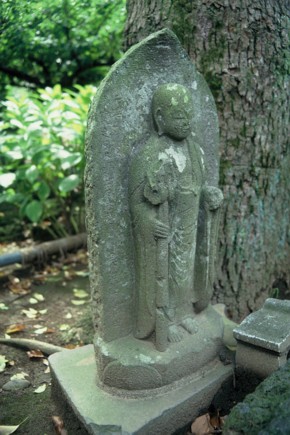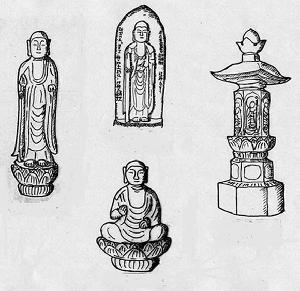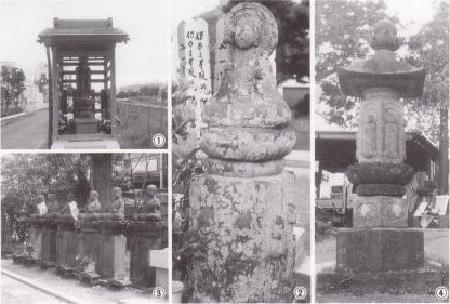Last updated: June 27, 2017

Jizo Bodhisattva Pagoda at Jorakuji Temple (Inagi City designated cultural property)
It is said that the belief in Jizo Bosatsu began in the Nara period. It spread after the Heian period when the idea of the end of the law (mapposhisou) became popular, and became popular as an object of worship for the common people. This faith is a faith of benefit in this world to be freed from the sufferings of this world and the sufferings that lead to the afterlife. It is thought that it appeared.
Stone Buddhas began to be built at the end of the Heian period, and in the Edo period they became widely established in rural villages as objects of worship for the common people, and began to be actively built. Among the stone Buddhas built during the Edo period, the Jizo Bodhisattva Pagoda is the most common, and it can be said to be a stone Buddha that represents the early modern period. Jizo is commonly seen in the shape of a monk, holding a hoju (a treasured ball that is said to make wishes come true) in its left hand and a shakujo (a walking staff carried by monks) in its right hand, making it a familiar Jizo. It will become universal as an object of faith.
There are currently 40 Jizo Bosatsu towers in Inagi City. Looking at the period in which they were built, it spans about 200 years from 1664 to 1860, with the largest number being built in the 1700s. Masu. They are often found along old roads, within temple grounds, and in cemeteries, but due to recent development work, many are no longer in their original locations. Regional distribution is mostly in Yanoguchi, Higashinaganuma, and Sakahama, and a somewhat concentrated distribution can be seen.
Let's take a look at the form and contents of the Jizo Bodhisattva Pagoda in the city. The forms include 22 round-carved standing statues, 7 round-carved seated statues, and a relief standing statue with a boat-shaped halo. They can be divided into 5 types: 9 examples (elephant), 1 example is a relief standing statue with a six-sided curtain, and 1 example is a combination of a round seated statue and a standing statue in relief. Of these, nine are set up in the form of Rokujizo. Looking at the relationship between the creator and faith, 16 cases were created by Nenbutsu kochu, 9 cases were created by multiple people, 6 cases were created by individuals, and 9 cases are unknown. This shows that many of them were built by people who were holding Nembutsu lectures in each region. It is also noteworthy that women are prominent among the creators. Examples with inscriptions such as ``Onna nenbutsu kochu'' and ``Soson maid'' indicate that they were particularly popular among women. . There are also examples of Jizo Bodhisattva belief being combined with other beliefs. It has relationships with various faiths, as can be seen in the inscriptions such as Koshin memorial service, Kyoten memorial service, Kaikoku memorial service, and Hashi memorial service. did.

Form of Jizo Bodhisattva Tower
| district | quantity |
|---|---|
| Yanoguchi | 10 |
| Oshidate | 1 |
| Higashinaganuma | 8 |
| Daimaru | 3 |
| 100 villages | 5 |
| Sakahama | 8 |
| Hirao | 5 |
| total | 40 |
Next, we will introduce the city's representative Jizo Bosatsu Pagoda.
The photo at the top of the page is the Jizo Bosatsu Pagoda, the oldest in the city, built in 1664, located within the grounds of Jōraku-ji Temple. It was built by the people of Shimoshinden, Naganuma Village. The inscription ``Kuyousoushuunananin'' indicates that it was also connected to the Koshin belief that was spreading in rural areas at the time. It is also the oldest Koshin Pagoda, and is an old-fashioned stone Buddha from before the blue-faced Kongo became popular as the main deity.
Photo 1 below is a Jizo Bodhisattva pagoda called ``Enmei Jizo'' that stands at the foot of a parapet bridge in Higashi-Naganuma.It received a unique name due to the faith of many people. is attached. There are other examples in the city with names such as ``Hachibe Jizo.'' Photo 2 is the one built on the grounds of Enkakuji Temple, and is a rare example of a combination of a round-carved seated statue and a Rokujizo statue carved in relief on the base stone. Photos 3 and 4 are Rokujizo, whose purpose is to rescue the dead who are in the suffering world of Rokudo Rinne. Number 3 is six seated statues located within the grounds of Jorakuji Temple, and number 4 is Rokujizoto, which stands at the entrance of the old approach to Koshoji Temple.

Jizo Bodhisattva Pagoda in the city
Inagi City Education Department Lifelong Learning Division Tel: 042-377-2121